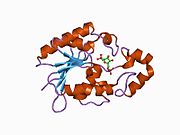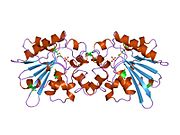6-phosphofructo-2-kinase/fructose-2,6-biphosphatase 1 is an enzyme that in humans is encoded by the PFKFB1 gene.[5][6]
This gene encodes a member of the family of bifunctional 6-phosphofructo-2-kinase:fructose-2,6-biphosphatase enzymes. The enzyme forms a homodimer that catalyzes both the synthesis and degradation of fructose-2,6-biphosphate using independent catalytic domains. Fructose-2,6-biphosphate is an activator of the glycolysis pathway and an inhibitor of the gluconeogenesis pathway. Consequently, regulating fructose-2,6-biphosphate levels through the activity of this enzyme is thought to regulate glucose homeostasis.[6]
References
[edit]- ^ a b c GRCh38: Ensembl release 89: ENSG00000158571 – Ensembl, May 2017
- ^ a b c GRCm38: Ensembl release 89: ENSMUSG00000025271 – Ensembl, May 2017
- ^ "Human PubMed Reference:". National Center for Biotechnology Information, U.S. National Library of Medicine.
- ^ "Mouse PubMed Reference:". National Center for Biotechnology Information, U.S. National Library of Medicine.
- ^ Batra RS, Hatchwell E, Rider S, Brown R, Brown GK, Craig IW (Apr 1997). "Localization of human liver 6-phosphofructo-2-kinase/fructose-2,6-bisphosphatase (PFKFB1) within a YAC contig in Xp11.21". Genomics. 40 (2): 358–61. doi:10.1006/geno.1996.4530. PMID 9119406.
- ^ a b "Entrez Gene: PFKFB1 6-phosphofructo-2-kinase/fructose-2,6-biphosphatase 1".
Further reading
[edit]- Lange AJ, Pilkis SJ (1990). "Sequence of human liver 6-phosphofructo-2-kinase/fructose-2,6-bisphosphatase". Nucleic Acids Res. 18 (12): 3652. doi:10.1093/nar/18.12.3652. PMC 331036. PMID 2163524.
- Marker AJ, Colosia AD, Tauler A, et al. (1989). "Glucocorticoid regulation of hepatic 6-phosphofructo-2-kinase/fructose-2,6-bisphosphatase gene expression". J. Biol. Chem. 264 (12): 7000–4. doi:10.1016/S0021-9258(18)83531-1. PMID 2540168.
- Algaier J, Uyeda K (1988). "Molecular cloning, sequence analysis, and expression of a human liver cDNA coding for fructose-6-P,2-kinase:fructose-2,6-bisphosphatase". Biochem. Biophys. Res. Commun. 153 (1): 328–33. doi:10.1016/S0006-291X(88)81226-9. PMID 2837207.
- Lee YH, Li Y, Uyeda K, Hasemann CA (2003). "Tissue-specific structure/function differentiation of the liver isoform of 6-phosphofructo-2-kinase/fructose-2,6-bisphosphatase". J. Biol. Chem. 278 (1): 523–30. doi:10.1074/jbc.M209105200. PMID 12379646.
- Strausberg RL, Feingold EA, Grouse LH, et al. (2003). "Generation and initial analysis of more than 15,000 full-length human and mouse cDNA sequences". Proc. Natl. Acad. Sci. U.S.A. 99 (26): 16899–903. Bibcode:2002PNAS...9916899M. doi:10.1073/pnas.242603899. PMC 139241. PMID 12477932.
- Gerhard DS, Wagner L, Feingold EA, et al. (2004). "The Status, Quality, and Expansion of the NIH Full-Length cDNA Project: The Mammalian Gene Collection (MGC)". Genome Res. 14 (10B): 2121–7. doi:10.1101/gr.2596504. PMC 528928. PMID 15489334.
- Ross MT, Grafham DV, Coffey AJ, et al. (2005). "The DNA sequence of the human X chromosome". Nature. 434 (7031): 325–37. Bibcode:2005Natur.434..325R. doi:10.1038/nature03440. PMC 2665286. PMID 15772651.
- Kimura K, Wakamatsu A, Suzuki Y, et al. (2006). "Diversification of transcriptional modulation: Large-scale identification and characterization of putative alternative promoters of human genes". Genome Res. 16 (1): 55–65. doi:10.1101/gr.4039406. PMC 1356129. PMID 16344560.












Well, that’s interesting to know that Psilotum nudum are known as whisk ferns. Psilotum nudum is the commoner species of the two. While the P. flaccidum is a rare species and is found in the tropical islands. Both the species are usually epiphytic in habit and grow upon tree ferns. These species may also be terrestrial and grow in humus or in the crevices of the rocks.
View the detailed Guide of Psilotum nudum: Detailed Study Of Psilotum Nudum (Whisk Fern), Classification, Anatomy, Reproduction